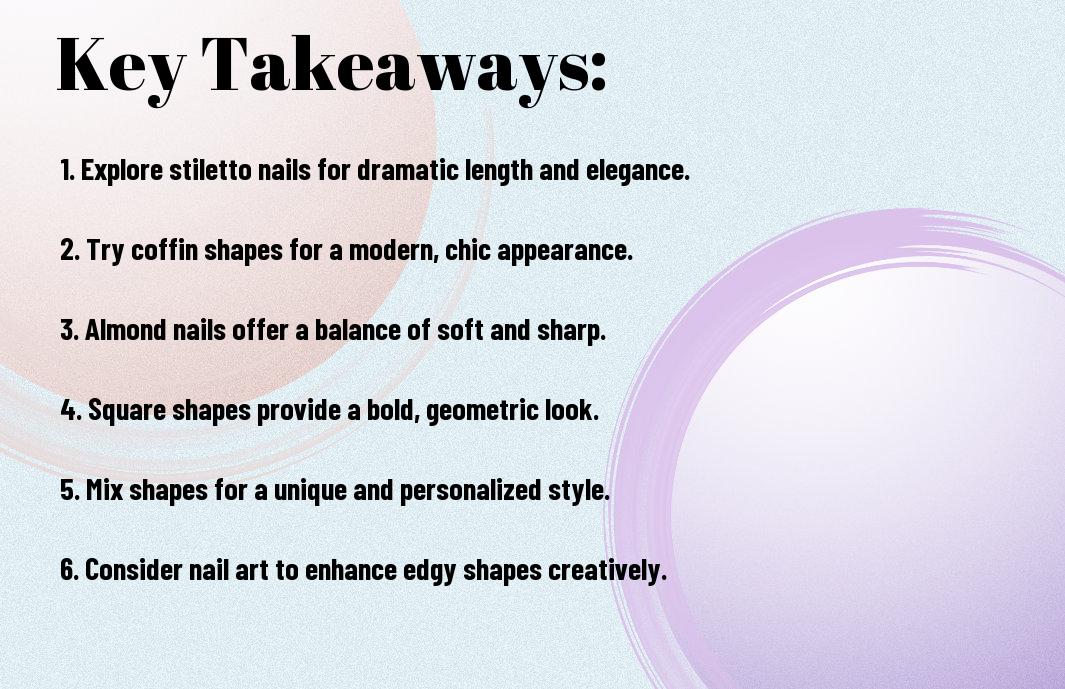You can achieve a stunning nail transformation by transitioning between shapes while avoiding breakage. With the right techniques and a little patience, you’ll maintain the integrity of your nails regardless of the style you choose. This post will provide you with expert advice to guide you step-by-step through the process, ensuring your nails stay healthy and strong while you experiment with various fashionable shapes. Let’s look into the best practices for achieving your perfect nail look without compromising their durability.
Key Takeaways:
- Gradual Shaping: Transition between nail shapes slowly to avoid stress on the nail and potential breaking.
- Proper Tools: Utilize the right tools, such as a fine-grit file, to minimize damage during the shaping process.
- Nail Care: Maintain strong and healthy nails through regular moisturizing and strengthening treatments, which helps with shape transitions.
Understanding Nail Shapes
To begin with, nail shapes play a significant role in how your nails look and feel. Familiarizing yourself with the different styles can help you identify what suits your preferences best. Explore 5 Nail Shapes (& How to Get ‘Em) to effortlessly navigate through the world of manicures.
Popular Nail Shapes
Beside the classic square and round shapes, other popular nail shapes include almond, stiletto, and coffin. Each shape has its unique flair, allowing you to express your personal style while also complementing your finger length and hand shape.
Factors Influencing Nail Shape Choice
Along with personal style, several factors will influence your choice of nail shape, including the health of your natural nails, your lifestyle, and the visual illusion you desire. Keep these points in mind:
- Your nail care routine and the strength of your nails
- Your daily activities and how they might affect your nails
- The shape that complements your hand and finger dimensions
Assume that choosing the right shape will enhance both your nail health and appearance.
Another aspect to consider when picking a nail shape is the maintenance involved. Certain shapes require more upkeep than others, so think about these factors:
- The frequency of salon visits for reshaping
- How often you engage in activities that could chip or break your nails
- Your willingness to invest time and money for upkeep
Assume that a well-chosen nail shape can minimize maintenance while still allowing for stylish nails.
Assessing Your Current Nail Condition
Some individuals underestimate the importance of evaluating the condition of their nails before transitioning to a new shape. Taking a moment to observe how your nails look and feel can save you from potential breakage and discomfort down the line. Ensure you assess for any signs of weakness, brittleness, or past damage, as these factors will play a significant role in how well your nails can handle a shape change.
Signs of Weak or Damaged Nails
By examining your nails closely, you may notice indicators of weakness such as peeling, splitting, or a lack of strength. If your nails bend easily or show unusual discoloration, this can also suggest damage. It’s crucial to identify these signs to make informed decisions about your nail care routine and shape transition.
Importance of Nail Health
Before you attempt to change your nail shape, prioritizing the overall health of your nails is fundamental. Healthy nails not only look better but are also more resilient and less prone to breaking or chipping during the transition process. Investing time in improving your nail health can lead to more satisfying results and a more enjoyable nail care experience.
Considering that your nails reflect your overall health, maintaining their strength and vitality is important for achieving the desired shape without stress. Incorporating elements such as a balanced diet rich in vitamins, adequate hydration, and proper nail care techniques will significantly enhance your nail’s durability. Strong, healthy nails will better withstand the shaping process, allowing you to transition smoothly and stylishly.
Preparing for the Transition
For a smooth transition between nail shapes, it’s imperative to prepare your nails properly. Start by researching the best tips for filing your nails into your desired shape. Check out What is the best tip you have for filing your nails into a … for insights from other nail enthusiasts.
Tools and Products Needed
About your tools, ensure you have a high-quality nail file, buffer, cuticle remover, and a nourishing cuticle oil. These items are imperative for maintaining nail health during your shape transition.
Steps for Nail Care Before Transition
Between nail shapes, prioritize nail care to prevent breakage. Start by trimming your nails to a manageable length and gently filing them to remove any rough edges. This will set a strong foundation for your new shape.
Transitioning between nail shapes can be a delicate process, but taking the time to care for your nails beforehand will help minimize potential damage. Hydrating your nails with cuticle oil and ensuring they are free from chips will strengthen them, making the transition smoother and promoting overall nail health.
Transition Techniques
Not every nail shape suits everyone, and transitioning can be tricky. To make changes without compromising the health of your nails, consider employing various techniques that allow for safe, gradual shifts in shape. This will not only help you achieve your desired look but also minimize the risk of breakage during the process.
Gradual Shaping Methods
With gradual shaping methods, you can slowly refine your nails into the desired shape over several manicures. Instead of a dramatic change, opt for subtle adjustments that keep your nails strong and healthy. This might involve slightly shortening or reshaping them with each visit to the salon, giving your nails time to adapt.
Tips for Avoiding Breakage
Gradual transitions can be easy on your nails if you follow some imperative tips for avoiding breakage. Stay attentive to your nail care routine to keep your nails strong during the process. Implement the following strategies:
- Avoid using your nails as tools.
- Hydrate your nails with oils and creams.
- Choose gel or shellac options for extra strength.
Assume that taking small steps will help maintain nail integrity while achieving your desired shape.
Additional Tips for Avoiding Breakage
For instance, you may also want to invest in a quality nail strengthener that can provide additional support during the transition period. Ensure you also file your nails in one direction to reduce splitting. Consider these suggestions:
- Maintain a balanced diet rich in vitamins and minerals.
- Trim your nails regularly to prevent snagging.
- Wear gloves when performing chores or using harsh chemicals.
Assume that consistency in care and caution will keep your nails healthy throughout your transition process.
Maintenance and Aftercare
After transitioning between nail shapes, it’s important to focus on proper maintenance and aftercare to keep your nails healthy and durable. Regular moisturizing and using a strengthening base coat will help protect your nails from damage. You should also avoid excessive filing and limit exposure to harsh chemicals to preserve your new shape and strength.
Enhancing Nail Strength Post-Transition
Aftercare is imperative for enhancing the strength of your nails after reshaping. Incorporate strengthening treatments like keratin-infused oils or serums into your routine. Regularly massage these products into your nails and cuticles to promote healthy growth and prevent breakage. With consistent care, your nails will thrive in their new shape.
Routine Care for Different Shapes
Strength is the foundation of maintaining different nail shapes, and your routine should reflect that. Each shape demands specific care and attention to keep them in optimal condition.
Plus, understanding the unique requirements for each nail shape will empower you to tailor your care routine effectively. For example, almond and oval shapes may benefit from regular buffing to maintain smooth edges, while square nails require careful trimming to avoid snagging. Keep your nails trimmed and filed regularly, ensuring that you adjust your techniques based on the shape you are maintaining, which will significantly reduce the risk of breakage and promote lasting strength.

Troubleshooting Common Issues
All transitions between nail shapes come with potential challenges, but they can often be managed with the right strategies. Whether it’s breakage, discomfort, or reshaping difficulties, understanding what to expect will help you navigate this process more smoothly. Stay informed and proactive to maintain the health of your nails while you adjust to your desired look.
Managing Breakage During Transitions
An necessary aspect of transitioning your nail shape is to be mindful of the increased risk of breakage. When you change shapes, the edges and stress points of your nails may become more vulnerable. To mitigate breakage, consider gradually filing your nails into your new shape rather than making drastic changes all at once. This gradual approach allows your nails to adjust and strengthens them over time.
Adjusting Nail Care Routines
Above all, adjusting your nail care routines can significantly impact how well your nails cope with the transition. This might involve switching to more nourishing products, increasing hydration, or adopting a gentler filing technique. Pay attention to your nails’ reaction during the transition and modify your routine accordingly to ensure they remain strong and healthy.
Adjusting your nail care routine is vital as it directly influences the strength and appearance of your nails. You might want to incorporate a weekly moisturizing treatment to keep your nails and cuticles hydrated. Additionally, consider using a strengthening base coat when applying polish to reinforce your nails. Cutting back on harsh chemicals and ensuring proper nutrition can also contribute positively to your nails’ resilience during this transition phase.
Conclusion
Hence, transitioning between nail shapes without breaking requires careful planning and technique. By understanding your current nail condition and taking steps to gradually reshape, you can maintain nail integrity while achieving your desired look. Utilize proper filing techniques and avoid excessive pressure to keep your nails healthy. For more detailed guidance, explore Nail Shapes 101: Shape Guide and How to File to elevate your nail care routine.
FAQ
Q: What steps should I take to safely transition from square to oval nail shapes?
A: To transition from square to oval nail shapes without risking breakage, start by gradually filing the corners of your nails. Use a fine-grit nail file for a smoother finish. File at an angle towards the center of the nail to create the rounded edges, making small adjustments as you go. It’s advised to do this over multiple sessions rather than all at once to avoid putting too much stress on the nail. Additionally, keep your nails well-moisturized and consider applying a strengthening treatment to help maintain their integrity during the transition.
Q: How can I maintain nail strength while changing shapes frequently?
A: To maintain nail strength during frequent shape changes, incorporate a regular nail care routine. This should include using a nourishing cuticle oil and a hardening base coat to promote growth and protect your nails. When filing, use a gentle touch and avoid aggressive back-and-forth motions, as this can weaken the nail structure. It can also be beneficial to take breaks between shape changes and allow your nails to rest and recover, ensuring they stay healthy and strong.
Q: Are there specific nail shapes that are easier to transition to without causing breakage?
A: Yes, some nail shapes are more forgiving when transitioning. For instance, moving from a square to a rounded shape tends to be easier on the nails, as it requires less filing and reduces the risk of hitting weak points. Similarly, transitioning from round to almond-shaped nails can also be smooth, as both shapes maintain a certain amount of curvature. Whenever trying a new shape, prioritize shapes that complement your natural nail structure, and avoid drastic changes that could cause undue stress on your nails.



